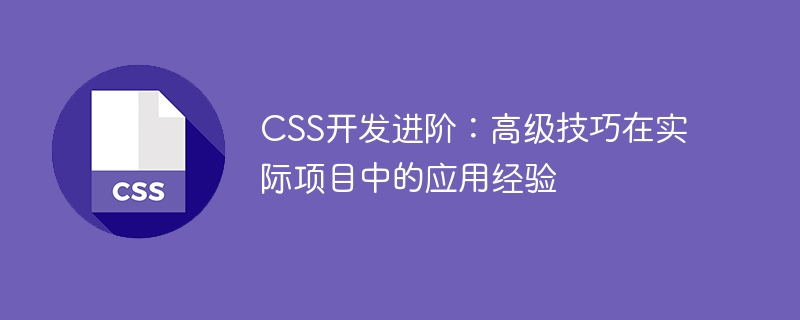Home >Web Front-end >CSS Tutorial >Advanced CSS development: application experience of advanced techniques in actual projects
Advanced CSS development: application experience of advanced techniques in actual projects
- WBOYWBOYWBOYWBOYWBOYWBOYWBOYWBOYWBOYWBOYWBOYWBOYWBOriginal
- 2023-11-02 11:36:40932browse

CSS (Cascading Style Sheet) is a commonly used web page style design language, used to define the layout, fonts, colors and other appearance of web pages. Its basic syntax is simple and easy to understand, but as the complexity of the project increases, individual developers or team developers may face some challenges. In this article, we will explore some advanced techniques for CSS development and share their application experience in real projects.
Section 1: Modular CSS
In large projects, using modular CSS can make the code more maintainable and extensible. Modular CSS divides styles according to functions, and each module is responsible for its own style. We can use BEM (block, element, modifier) or other similar naming conventions to name CSS classes, which can avoid style conflicts and naming confusion.
Section 2: Responsive Layout
As mobile devices become more and more common today, responsive layout has become an indispensable skill. Media queries in CSS can dynamically adjust layout and style according to different sizes and orientations of the device. By using media queries and flexbox layout, we can easily create web pages that adapt to different devices.
Section 3: CSS Preprocessor
CSS preprocessor (such as Sass, Less or Stylus) can help developers write more efficient and easier to maintain CSS code. Using variables, nested rules, mixins and other functions can reduce duplicate code and improve code readability. The preprocessor also provides advanced features such as functions, loops, and conditional statements, making CSS development more flexible and powerful.
Section 4: Animation and Transition Effects
Animation and transition effects in CSS can add vividness and interactivity to web pages. By using CSS3 animation properties, we can create smooth transitions and animations without relying on JavaScript. Using keyframe animation (keyframes) allows you to control each frame of the animation more precisely, allowing for more complex and beautiful effects.
Section 5: Performance Optimization
In large projects, optimizing the performance of CSS is very important. Some common performance optimization tips include using appropriate selectors, avoiding excessive nesting and levels, compressing and merging CSS files, etc. Through the reasonable use of CSS preprocessors and browser caching mechanisms, the loading time of web pages can be reduced and the user experience can be improved.
Section 6: Browser Compatibility
Different browsers have different support for CSS, so it is a challenge to ensure that web pages are displayed correctly in various browsers. During development, we can use browser compatibility prefixes and specific hacks to solve some compatibility issues. In addition, promptly updating the CSS framework and using CSS Reset styles are also important steps to ensure cross-browser compatibility.
Summary:
This article briefly introduces some advanced techniques of CSS development and shares their application experience in actual projects. By learning and practicing these techniques, we can improve the efficiency and quality of CSS development and create beautiful, responsive and high-performance web pages. However, CSS technology is developing at a rapid pace, and we need to continue to learn and explore the latest technologies and tools to adapt to the changing needs of web development.
The above is the detailed content of Advanced CSS development: application experience of advanced techniques in actual projects. For more information, please follow other related articles on the PHP Chinese website!

